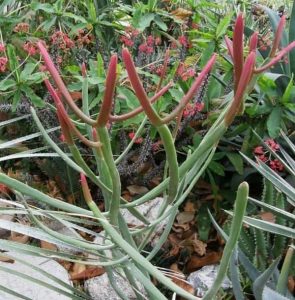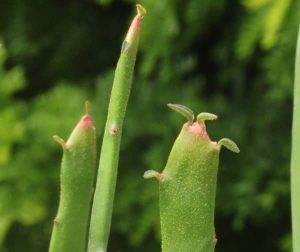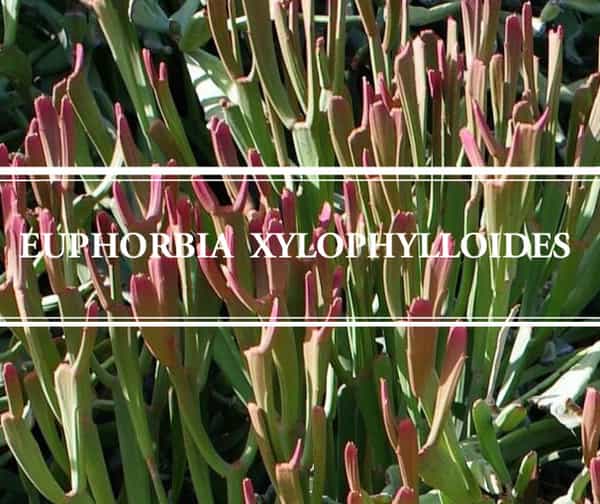Do you know that some plants are all branches without any leaves at all? Yes! The Euphorbia xylophylloides is a unique plant native to Madagascar. Initially, the green, flat, ribbon-like branches grow upward forming a crowned shrub. In addition, the plant matures to grow lateral branches creating a non-symmetrical plant body. Moreover, in the availability of open space, this unique plant may form a huge tree.
The “branchy shrub” can do well both indoors and outdoors. This plant is unique enough to give the desired touch of class to your surroundings. Interesting? Let us know more about this leafless Xyllophiloides plant along with its care, propagation, and an estimated growth timeline.
Euphorbia Xylophylloides Classification
Family: Euphorbiaceae
Genus: Euphorbia
Species: E. xylophylloides
Family Euphorbiaceae
Euphorbiaceae is the fifth biggest flowering family. It comprises about 75000 species. Commonly, these plants belong to the tropical regions of America. In addition, a few are native to Africa and non-tropical zones including Middle East, South Africa, and South America. The family is a house of diversity including succulents, herbs, shrubs, and large trees.
It would be informative for you that the names Euphorbia and spurge are often used as a title for this family. However, in reality, they are the botanical and common names of the genus respectively.
Genus Euphorbia
Euphorbia proudly attains a position among one of the largest genera of flowering plants. Currently, it comprises about 2000 recorded species. This is a diverse genus including perennial, annual, and biannual plants. Moreover, they include all sizes of plants, from small-sized woody shrubs to huge trees.
The main features of the Euphorbias include remarkable appearance and ability to stand drought and high temperatures. In addition, the plants contain a white milky inner-latex. This sap is highly toxic in nature.
These plants are popular for their ornamental usage. Moreover, they are widely cultivated and commonly sold in markets. Another common usage of the members of this genus is using inner latex as a purgative. This is the reason for the common name “spurge” of the genus. While the word comes from the ‘purging’.
Difference Between Euphorbias and Cacti
Euphorbias are commonly confused and sometimes labelled as cacti. The reason being is that they share many common characteristics with them. However, they are not cacti. The basic differences between the two genera are;
- Nondescript flowers, thorny body, and the inner milky sap of Euphorbias.
- Alternatively, the cacti have well-defined flowers, spines instead of thorns and do not have the toxic milky latex.
Euphorbia Xylophylloides Common Name
- E.enterophora.
Euphorbia Xylophylloides Plant Features

Height and Structure
- In case the space is available, the plant may reach up to a height of about 20m. However, the normal height of the plant in the domestic environment remains under 5 feet.
- The new branches are reddish in color and beautifully turn green on maturity.
Toxicity
Milky white sap is the characteristic feature of the Euphorbias. This sap is highly toxic in nature. Thus, keep the plant at a suitable place where kids and pets can’t mingle with the plant.
Dormancy
All the Euphorbias show slow growth on the cold winter days. Just don’t get worried and don’t do anything extra. Water the plant once in two weeks. Moreover, allow the soil to get completely dry before the next watering. In addition, no fertilizer is absorbable by the plant at this stage. The growth frequency will be at a healthy pace, as soon as the summer arrives.
Euphorbia Xylophylloides Care
Water Requirement
Xylophylloides are usually drought-tolerant plants, just like the majority of cacti. This plant can tolerate a few weeks of benign neglect. The simple watering technique is to water after the soil gets completely dry. An estimated frequency for summer is to water sparingly once or twice a week. Howbeit, in winter, you can reduce the watering to once in two to three weeks. Make sure the soil is bone dry before you water again.
Importantly, wet feet and soggy soil are a big ‘no-no’ for the plant. Thus, make sure you avoid over-watering.
Sunlight Requirement
These plants are desert dwellers and like to be in full sun. Bright Indirect sunlight is ideal for the plant. However, they can do well in partial shade. We don’t recommend long hours of exposure to direct sunlight, especially in hotter zones.
Temperature Requirement
The ideal temperature range for the plant is 10 to 35 °C. Unlike a number of cacti, they are a little frost hardy and can bear temperature up to 0 °C (32 °F).
Soil Requirement
Well-drained growing mediums with large particles are ideal for the plant. You can use a mixture of perlite and regular peat as well. One of our friends grew it with a base layer of brick and charcoal pieces covered by the sandy loam. This came out to be pretty successful for the plant. The PH should be acidic to neutral (PH 5 to 7).
Humidity Requirement
These plants dwell in a low humidity environment. So, you don’t need any extra effort to maintain the humidity levels.
Fertilizer Requirement
Added nutrition will be welcomed. A 247 or 347 cactus fertilizer will be suitable to use quarterly, focusing on the growing season.
Pruning Requirement
You can remove a few branches from the lower sides. This will help you to maintain the shape and appearance of the plant according to your taste. Cutting out old and unhealthy branches also enhances the health of the plant.
Re-potting Requirement
Repotting is not essential unless the plant looks prominently bigger. Another sign of repotting requirement is when the roots come out of the drainage holes.
Just use some suitable gardening tools to loosen the soil around the plant. Take out the plant gently and shake any old soil on the roots. Plant the base in the desired bigger pot and firm the soil by patting.
Hardiness Zones
Optimum growth zones are USDA zones 9 to 11.
Euphorbia Xylophylloides Propagation

- Seeds.
- Stem-cuttings.
It usually takes a good time to get an attractive and developed plant from the seeds. Thus, it is not a recommended method especially if you lack patience.
Propagation by Stem-Cuttings
The ideal time to try propagation your E.enterophora is spring and summer.
Method
- Use a sharp knife to cut 5 to 7 inches of stem from a healthy plant. It would be great if you cut from the joint between the main stem and the branch.
- Now, let it get dry for a week to form a callus.
- Dip the base of the cutting in a growth hormone and plant it in the desired place.
- The soil should be dry, loose, and well-draining.
Caution
All the parts of euphorbias ooze a white fluid. This is highly toxic in nature. Thus, it should bit come in contact with your skin and eyes. It would be great if you use disposable gloves. Secondly, try washing the gloves before discarding them. This will keep any stray animals safe from being affected by the toxic milky substance. In the end, wash your hand thoroughly to ensure safety.
Growth Timeline
We usually share an assumed growth process of the plant. This is supposed to help you understand the care required at each stage.
Day 1 to Day 30: Keep the plant in someplace with indirect light of medium to bright intensity. Use a spray bottle to mist the soil once or twice a week. Water when the soil just gets dry. Root development starts by the end of the third week.
Day 30 to Day 90: After the first month, you will notice shoot development. Keep the care as stated in the first stage.
Day 90 Onwards: The plant baby plant will be quite developed by now. You no longer need to use a spray bottle. Just follow the Euphorbia xylophylloides Care stated above and enjoy the growth of leafless enterophora branches.
Related Post:
Summary
The Euphorbia xylophylloides is a unique Euphorbian, native to Madagascar. The leafless, flat, ribbon-like branches grow to form erect shrubs. Later on, a large number of lateral branches grow in a horizontal direction. This turns the plant body into an irregular mass.
This plant is suitable enough for both indoor and outdoor decoration. This a low-maintenance plant, needing bright light and watering after the soil gets dry. All the parts of the plant contain toxic white latex. Thus, be careful and keep it out of the reach of kids and pets.

